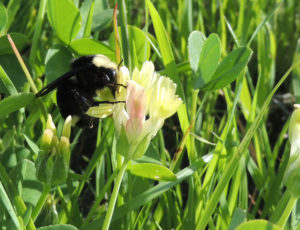Q: I’ve heard bees can see colors that people can’t. What about birds? Can they also see more colors? How do scientists figure out what can be seen by other animals, especially small animals like insects? [Anne, Fremont]
A: I occasionally like to conduct a reality check about my own awareness of the universe. The world, as I perceive it, is only a representation that I create from data filtered through my feeble senses. Other animals have a completely different worldview. Rattlesnakes are sensitive to infrared energy (heat). They can “feel” the warmth from a jackrabbit at a distance. Bats and porpoises use sound to “see” in total darkness and even distinguish the density of an object at a distance. Bees, as you have heard, can see colors in the ultraviolet (UV) range that humans cannot. The perceived realities of various creatures can be very different and all true.
We can’t see in the ultraviolet range–our eyes block that frequency, which can harm our retinas. Snow blindness is one result of too much UV, as is sunburn. But humans can see at least one color that bees cannot–red.
Flowering plants have evolved to maximize pollination. Some are pollinated by wind, water, bats, and birds, but by far insects are the commonest vectors. Plants have evolved showy flowers full of nectar and extra-tasty pollen to entice insects.
Plants have methods for making sure insects find their way to the Promised Land. Just shine a blacklight on a flower to see it revealed as a honeybee sees it. There are suddenly incredibly obvious floral tracks that resemble runway landing lights, which guide the insect clearly. Some flowers even have pollen grains that glow in ultraviolet light.
Birds, on the other hand, can see both ultraviolet and red. Consequently flowers that are pollinated by birds (usually hummingbirds in the New World and sunbirds in the old) are usually red or at least brightly colored. Birds’ eyes have at least four types of light-receptive cones (compared to our three) and have much richer color vision than we do, aiding in orientation, food gathering, and mate selection.
Vision in mammals and birds relies on light-sensitive pigments created and stored in rods and cones in the eye. Scientists can make assumptions about how an animal sees by observing the concentration of these pigments. Animals with just rods can’t see color but have excellent night vision.
Insects and other invertebrates use different visual pigments that function just as well or even better than the rods and cones we use. The mantis shrimp has the most complex eyes of any animal. Scientists have found that even amoebas can tell light from dark–not too shabby for little single cells!
Email your questions to atn@baynature.org.

.jpg)



